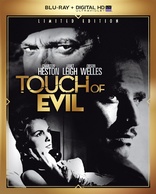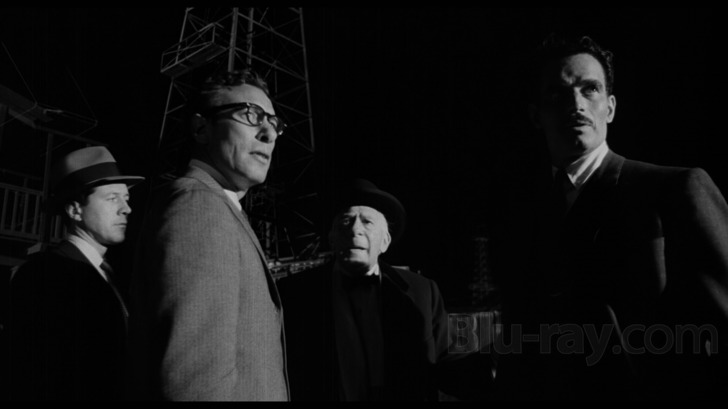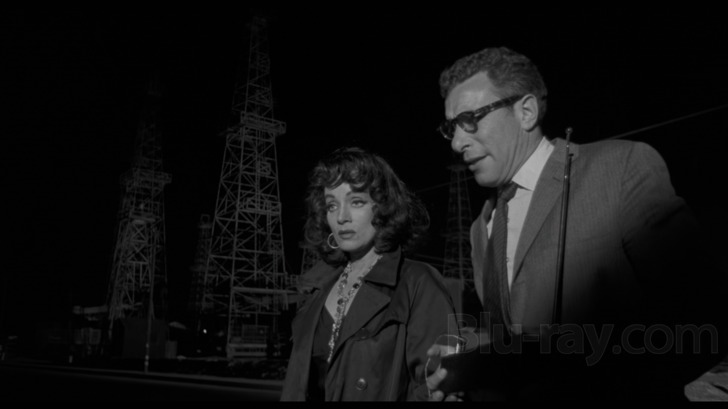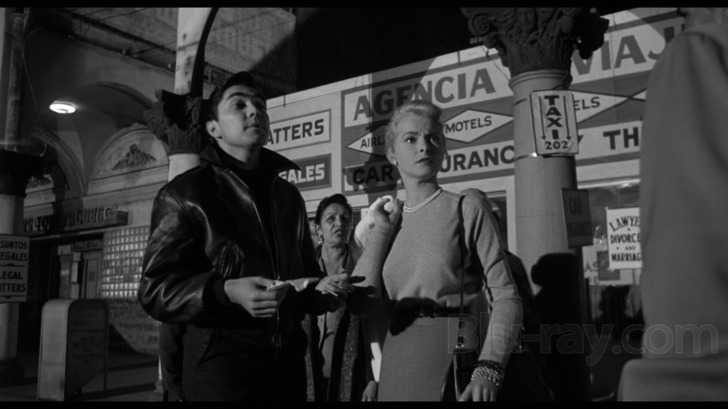Touch of Evil Blu-ray Movie
HomeTouch of Evil Blu-ray Movie 
Limited Edition / Blu-ray + UV Digital CopyUniversal Studios | 1958 | 1 Movie, 3 Cuts | 111 min | Rated PG-13 | Apr 15, 2014

Movie rating
8.3 | / 10 |
Blu-ray rating
| Users | 0.0 | |
| Reviewer | 4.5 | |
| Overall | 4.5 |
Overview
Touch of Evil (1958)
After a murder is committed in a small town right on the US-Mexico border a rogue cop from the US tries to frame his Mexican counterpart for it.
Starring: Charlton Heston, Janet Leigh, Orson Welles, Joseph Calleia, Joanna Moore (III)Director: Orson Welles
| Film-Noir | Uncertain |
| Psychological thriller | Uncertain |
| Crime | Uncertain |
| Thriller | Uncertain |
Specifications
Video
Video codec: MPEG-4 AVC
Video resolution: 1080p
Aspect ratio: 1.85:1
Original aspect ratio: 1.85:1
Audio
English: DTS-HD Master Audio 2.0 Mono (48kHz, 24-bit)
Subtitles
English SDH, French, Spanish
Discs
50GB Blu-ray Disc
Single disc (1 BD)
UV digital copy
Playback
Region free
Review
Rating summary
| Movie | 4.5 | |
| Video | 4.5 | |
| Audio | 4.5 | |
| Extras | 4.5 | |
| Overall | 4.5 |
Touch of Evil Blu-ray Movie Review
Touch of Edit
Reviewed by Michael Reuben April 14, 2014Some films draw strength from their flaws. Orson Welles's last film as a Hollywood director, the pulp thriller Touch of Evil, was a flop when Universal first released it in 1958, and even Welles's most devoted fans had to admit that much was wrong with the picture. But word quickly spread that Welles had not been allowed to finish Touch of Evil as he wanted, that Universal had taken it out of his hands, shot additional scenes, and re-edited major sequences. Just another tale of a brilliant artist's vision ruined by a heartless studio. But the real story isn't so simple or straightforward. Touch of Evil was hardly a passion project for Welles. Originally titled Badge of Evil after the novel by Whit Masterson, the production was initially intended as a straightforward crime film. Welles was cast as the villain, and the studio used his participation to lure Charlton Heston to play the hero. It was Heston who suggested that Welles direct, and Welles, eager to show a major studio that he still "had it", took the job as a director-for-hire. But being Orson Welles, he couldn't help but transform a genre film into something more substantial. He rewrote much of the script and reconceived the entire movie, even though he wasn't being paid for it. But after bringing in the film on time and within budget, Welles made a critical mistake. He left during post-production and went to Mexico to develop one of his own projects. Even Heston, who staunchly defended his choice of director to the end, conceded that Welles's timing was disastrous. The studio liked what they saw in dailies, but no one except Welles understood how it all fit together. In his absence, they made what they could out of his footage and shot new scenes where they thought them necessary, some of which Welles liked when he saw them. Overall, though, when the director finally resurfaced in December 1957, he was appalled by what Universal screened for him. He immediately went home and wrote a now-famous 58-page memo pleading with the studio to make various changes. But it was too late. The studio wanted to be done with Touch of Evil, and the film was released in its 95-minute Theatrical Version on April 23, 1958. In the mid-1970s, Universal discovered an alternate version of Touch of Evil in the archives. At 108 minutes, this Preview Version post-dated Welles's memo and included more of his original footage, but it did not reflect most of his suggestions. Nevertheless, Universal released it to theaters (and later to home video) as "complete, uncut and restored". In fact, there never has been and never will be such a version of the film, because Welles himself was never allowed to finish it. But in the late 1990s, producer and passionate Touch of Evil fan Rick Schmidlin persuaded Universal to fund a "reconstruction" of the film along the lines of Welles's 58-page memo. Meticulously assembled by Oscar-winning editor Walter Murch, this Reconstructed Version appeared in theaters and on DVD in 1998, and prompted a complete re-evaluation of Touch of Evil by scholars and film fans. Touch of Evil was previously released on Blu-ray in a region B-locked special edition as part of the "Masters of Cinema" series from Eureka Entertainment. That edition contained five versions: the Theatrical and Reconstructed Versions in both 1.85:1 and 1.37:1, plus the Preview Version in 1.85:1. Universal is now issuing the film in region A with 1.85:1 presentation of the three versions and the same on-disc extras.

Touch of Evil has a convoluted plot. One of Universal's biggest concerns was that audiences wouldn't be able to follow it. Ironically, in their efforts to clarify the plot, the studio muddled it further, so that the Theatrical Version makes less sense than the Reconstructed Version. What the studio executives didn't understand was that Welles had transformed their routine crime story into a pulp nightmare where ordinary logic doesn't apply. The film begins with an elaborately staged double murder that, as it turns out, has almost nothing to do with the plot. The victims are a wealthy American builder, Rudy Linnekar (Jeffrey Green) and a female companion, but these deaths gradually become irrelevant to the point where you may miss the crime’s solution if you miss a few stray lines of dialogue near the end. (Indeed, some experts believe that the crime is never really solved.) The key point is that the killings occur on the U.S.-Mexican border, creating a potential jurisdictional conflict and bringing two adversaries face to face. One of them is Mike Vargas (Heston), the American-educated Mexican head of the Pan-American Narcotics Commission; Vargas is taking a few days to honeymoon with his new wife, Susan (Janet Leigh), before returning to Mexico City to testify against a key member of the Grandi Family crime syndicate. The other adversary is Captain Hank Quinlan (Welles) of the Los Robles police, a dissolute bully whose methods of investigation are less than honest. The two men hate each other almost on sight. The notion of borders and "crossing the line" is integral to Touch of Evil. Quinlan has crossed it many times in his career, often justifying his conduct in the pursuit of some higher purpose. His closest friend, Sgt. Pete Menzies (Joseph Calleia), has supported him at every turn, but the Linnekar investigation will stretch their friendship to the limit, especially as Quinlan becomes obsessed with Vargas. Vargas and Susan have both crossed a line by marrying outside their nationality (a hot button issue in the Fifties, as Welles certainly knew), and many more lines will be crossed when a member of the Grandi Family, "Uncle Joe" (Akim Tamiroff), kidnaps Susan for leverage against her husband in the upcoming proceedings in Mexico City. The scene of Susan's captivity is a remote motel, where she is subjected to unspeakable torment at the hands of a gang led by Uncle Joe's nephew, the evil Pancho (Valentin de Vargas). Adding to the sense of being cut off from civilization is the motel's night manager (Dennis Weaver), an eccentric and sexually repressed grotesque who appears to inhabit his own world. (It is believed that Alfred Hitchcock was a fan of Touch of Evil, and after you've seen Weaver's performance, it's hard to deny that at least some part of Welles's film must have spilled over into Psycho.) Unaware of his wife's jeopardy, Vargas is digging into Quinlan's past, motivated in part by the captain's decision to accuse a young Mexican of the Linnekar murders based on evidence that Vargas knows was planted. Quinlan now finds himself making an alliance with Uncle Joe to destroy their common enemy (thereby crossing yet another line). The decision is a high-stakes gamble for both Quinlan and Uncle Joe, and one senses early on that it won't work out well for them. "Come on, read my future for me", Quinlan says to Tanya, the gypsy who used to be his girlfriend (and who is played by Marlene Dietrich, as a personal favor to Welles). "You haven't got any", she replies. "Your future's all used up." Welles fills the frame with interesting detail, layers the soundtrack with overlapping dialogue, and lets the drama pose intriguing questions that resonate far beyond Touch of Evil's surreal conclusion. "A policeman's job is only easy in a police state", snarls Vargas self-righteously at Quinlan, but when he learns that Susan is missing, he casts off the restraints of the law without a moment's hesitation. "Listen", he yells, as he trashes the bar where Pancho's gang is drinking. "I'm no cop now. I'm a husband! What did you do with her?" Could it be that, under the right circumstances, Vargas could transform into Quinlan, a good detective but (in Tanya's words) "a lousy cop"? What kind of man chooses to spend his honeymoon in a border town, a place that, by his own admission, "bring[s] out the worst in a country"? We learn from Quinlan's exchanges with Tanya that he once was slender and attractive, much like Vargas is now. Does Vargas really hate him, or does he fear that he may become him? Touch of Evil is full of such riddles, and more emerge on each viewing. For an enlightening look under the surface, be sure to listen to the commentary on the Theatrical Version by Jonathan Rosenbaum and James Naremore.
Touch of Evil Blu-ray Movie, Video Quality 

Unlike the Masters of Cinema edition released in November 2011, Universal's release of Touch of Evil arrives without any notes providing technical details about the transfer. Since I do not have either the MOC version or a region-free player, no attempt has been made to compare the two presentations. However, the three versions—Theatrical, Preview and Reconstructed—are presented via seamless branching, which at least suggests that new scans and remastering have been performed on all three versions. Certainly there is no obvious difference in quality that immediately distinguishes one version from another, although certain key footage that exists only in the Preview and Reconstructed Versions has faint vertical scratches that were apparently beyond repair. (They are primarily in the sequence showing how Susan Vargas gets to the motel where she is assaulted.) In general, however, the image on Universal's 1080p, AVC-encoded Blu-ray is a knockout. The detail is superb, the blacks are gorgeously deep, and the interplay of light and shadow that is so critical to cinematographer Russell Metty's compositions is reproduced with precision, as are the shadings of gray that support Welles's trademark use of deep focus photography. In the climactic (and very dark) sequence where Vargas tails Quinlan, whom he hopes to trap into a confession, layers of detail are revealed in the derelict surroundings that I have never seen in any previous home video presentation. Minutia such as the decor in the apartment of Quinlan's chief suspect (where Welles staged an uninterrupted shot that lasted over thirteen minutes) remain clearly visible, as do the characters entering and exiting the frame. In a pleasant departure from Universal's common practice of using ditigal processing to confer a video appearance on its catalog titles, Touch of Evil looks like film. A fine grain pattern is visible, and the image does not bear obvious indications of high frequency filtering, artificial sharpening or other untoward manipulation. (Note: Screencaps 1-27 are all taken from the Reconstructed Version, although many of these frames also appear in one or both of the other two versions. Screencaps 28-31 are specific to either or both the Theatrical and/or the Preview Versions.)
Touch of Evil Blu-ray Movie, Audio Quality 

Touch of Evil was released in mono, which is reproduced on Blu-ray in two-channel lossless DTS-HD MA. But there are significant differences between the mixes for the Reconstructed Version and the other two. Welles had intended his entire opening sequence leading up to the murders to be accompanied by environmental sounds, including source music heard from car radios and nightspots, which would rise and fall as Mike and Susan Vargas walk through the streets toward the border checkpoint. Universal opted instead to score the sequence traditionally with a cue that Henry Mancini had written for the soundtrack, which is also heard later in the film. It's an excellent cue, and some fans (such as commentator F.X. Feeney) prefer the Mancini soundtrack, but this was not Welles's intention. Editor Walter Murch, who is also an Oscar-winning sound mixer, has recreated Welles's preferred sound design to perfection for the opening sequence, which makes it an entirely different experience. (The sequence also plays without titles in the Reconstructed Version, an improvement that no one disputes.) Numerous tweaks have been made throughout the Reconstructed Version, including improved synchronization. Producer Rob Schmidlin points out many of these small changes in his solo commentary. At the same time, the reconstruction team did not try to "improve" or "sweeten" the original mix. It still sounds like a mono mix made for a 1958 film, with appropriate, but very good, dynamic range and fidelity. The dialogue is clear, and Mancini's score, which is now used more sparingly, still sounds wonderful.
Touch of Evil Blu-ray Movie, Special Features and Extras 

Universal previously released the Reconstructed Version of Touch of Evil on DVD in 2000 with only a trailer and Welles's 1957 memo as extras. In 2008, the studio released a two-disc "50th Anniversary Edition" with the three versions of the film included on the Blu-ray and the extras listed below, all of which have been ported over:
- Bringing Evil to Life (480i; 1.33:1; 20:59): This short documentary focuses on the film's production, with contributions from actors Heston, Leigh, Weaver and Valentin de Vargas and filmmakers Peter Bogdanovich and Robert Wise, among others.
- Evil Lost & Found (480i; 1.33:1; 17:06): An overview of the reconstruction, with interviewees that include editor Walter Murch, restorationist Bob O'Neil, reconstruction producer Rick Schmidlin, Welles scholar Jonathan Rosenbaum and cinematographer Allen Daviau.
- Theatrical Trailer (480i; 1.33:1; 2:10): Almost comically lurid.
- Commentaries
- Reconstructed Version with Charlton Heston, Janet Leigh and Reconstruction Producer Rick Schmidlin: The two stars of the film share their memories of working with Welles, while Schmidlin alternates between pointing out specific changes and prompting the actors with questions about their experience. Some of the stories from Heston and Leigh are repeated in the two documentaries, but with their memories prodded by Schmidlin, they relate additional detail that makes this track especially entertaining.
- Reconstructed Version with Rick Schmidlin: In his solo commentary, Schmidlin recounts in detail the lengthy history of his efforts to interest Universal in reconstructing the film in accordance with Welles's memo and his subsequent work with editor Walter Murch on the reconstruction.
- Theatrical Version with Writer/Filmmaker F.X. Feeney: As a long-time fan of the film, even as initially released, Feeney is the ideal guide to its themes, nuances and visual strategies. Although he notes various plot holes that are addressed in the Reconstructed Version, he makes a respectable case for the efficacy of the Theatrical Version.
- Preview Version with Orson Welles Historians Jonathan Rosenbaum and James Naremore: This is an informative commentary by two fans of the film, but it provides very little information about the Preview Version itself or any comparison between it and the Theatrical Version. Instead, the two commentators focus the film's themes and Welles's underlying concerns, subjects they are uniquely qualified to address.
- Orson Welles's 1957 Memo: The 58-page memo that Welles wrote to Universal on December 5, 1957, which served as a guide to the 1998 reconstruction, is included as a printed booklet. This is a much more convenient format than the on-disc version included on DVD.
Touch of Evil Blu-ray Movie, Overall Score and Recommendation 

It's unfortunate that we will never have the final version of Touch of Evil that Orson Welles envisioned when he was shooting the film for Universal. What we have, though, is a unique and memorable creation of such compelling power that an unprecedented effort was mounted to bring the film as close to its creator's vision as the existing materials would allow. In whatever version you choose to see it, Touch of Evil makes a lasting impression. Universal's Blu-ray presentation is first-rate and highly recommended.
Other editions
Touch of Evil: Other Editions
Similar titles
Similar titles you might also like

The Third Man
StudioCanal Collection
1949

The Big Heat 4K
1953

Kiss Me Deadly
1955

Blue Velvet 4K
1986

Double Indemnity 4K
1944

In the Heat of the Night 4K
1967

Mr. Arkadin
1955

Killer's Kiss 4K
1955

The Two Jakes 4K
1990

The Lady from Shanghai 4K
1947

The Long Goodbye
4K Restoration
1973

Devil in a Blue Dress 4K
1995

The Big Combo
1955

On the Waterfront
1.66:1, 1.85:1, and 1.33:1 aspect ratio presentations
1954

Night Moves 4K
1975

Out of the Past
Warner Archive Collection
1947

The Killers
1946

The Night of the Hunter
1955

Pickup on South Street
1953

I Confess
Warner Archive Collection
1953



